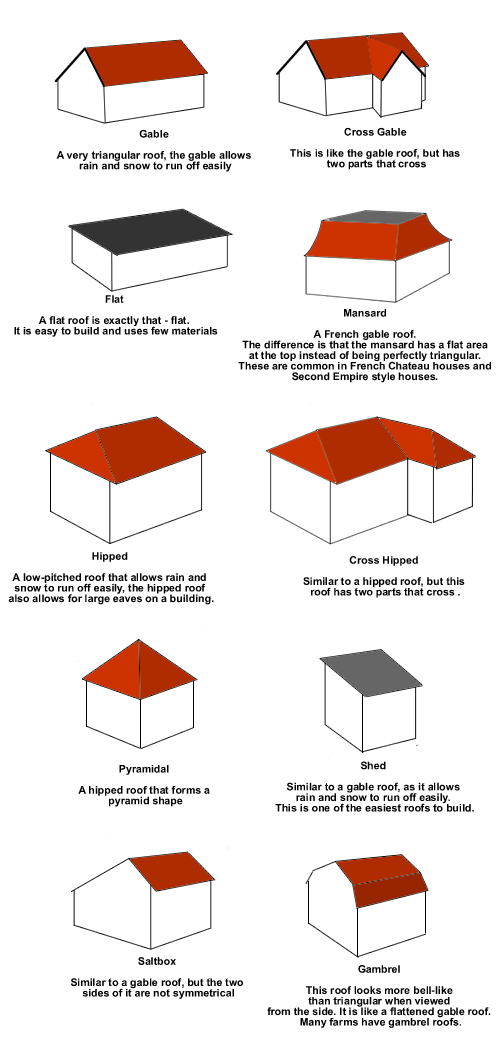|
styles of roofs
The roofs of buildings also define regions
and the era of construction. Cold climate usually have steeper pitched
roofs which will shed the weight of snow more easily. Often, the increase
in roof space allowed further stories, resulting in dormer windows.

Roofs in hotter climates have a lower pitch
but often have big overhangs to provide shade.

The least satisfactory and attractive roof is
a flat one. This is probably why they have been so loved by some of our
potty architects!

Below is a guide showing the most common
types of roofs.

The weather proofing material is the topmost
or outermost layer, exposed to the weather. Many materials have been used
as weather proofing material:
-
Thatch is roofing made
of plant material, in overlapping layers.
-
Wheat Straw, widely used
in England, France and other parts of Europe.
-
Seagrass, used in
coastal areas where there are estuaries such as Scotland. Has a longer
life than straw. Claimed to have a life in excess of 60 years.
-
Shingles, Wood shingles
longer than 16" are called shakes in North America. Shingles is the
generic term for a roofing material that is in many overlapping
sections, regardless of the nature of the material.
-
Red cedar. Life
expectancy, up to 30 years. However, young growth red cedar has a short
life expectancy. High cost. Should be allowed to breathe, usually
installed on lath strip for this purpose. The lath may rest on a roof
deck with underlay or be fastened directly to the rafters.
-
Hardwood. Very durable
roofing found in Colonial Australian architecture, its use now limited
to restorations.
Slate. Higher cost with a life expectancy of 50 to 200 years depending
on the thickness and type of slate used. Being a heavy material, the
supporting structure must be rated to support the weight load.
-
Ceramic tile. High cost,
life of 20-100 years.
-
Imbrex and tegula, style
dating back to ancient Greece and Rome.
-
Metal shakes or
shingles. Long life. High cost, suitable for roofs of 4/12 pitch or
greater. Because of the flexibility of metal, they can be manufactured
to lock together, giving durability and reducing assembly time.
-
Mechanically seamed
metal. Long life. High cost, suitable for roofs of low pitch such as
0.5/12 to 3/12 pitch.
-
Concrete, usually
reinforced with fibres of some sort. Not suitable in climates that
experience many freeze/thaw cycles during a year which will cause this
type of material to form cracks and fail.
-
Asphalt shingle, made of
bitumen embedded in an organic or fibreglass mat, usually covered with
coloured red, man-made ceramic grit. Cheaper and lighter than slate or
tiles. Life expectancies vary from 20 to 50 years depending on the
product. Sun is the enemy of asphalt shingles so longer life can be
expected in cloudier locations or at higher latitudes.
-
Asbestos shingles. Life
spans vary. Fireproof. Rarely used anymore because of health concerns.
Abatement costs can be high when the old roof needs to be replaced and
is subject to additional state and local environmental regulation and
oversight.
-
Membrane. membrane
roofing is in large sheets, generally fused in some way at the joints to
form a continuous surface.
-
Thermosetting plastic
(e.g. EPDM rubber). Synthetic rubber sheets adhered together with
contact adhesive or tape. Primary application is big box store with
large open areas and little vertical protrusions.
-
Thermoplastic (e.g. PVC,
TPO, CSPE). Plastic sheets welded together with hot air creating one
continuous sheet membrane. Can be re-welded with the exception of CSPE.
Lends itself well to both big box and small roof application because of
its hot air weldability.
-
Modified bitumen – heat
welded, asphalt adhered or installed with adhesive. Asphalt is mixed
with polymers such as APP or SBS, then applied to fibreglass and/or
polyester mat, seams sealed by locally melting the asphalt with heat,
hot mopping of asphalt, or adhesive. Lends itself well to all
applications.
-
Built-Up Roof – Multiple
plies of asphalt saturated organic felt or coated fibreglass felts.
Plies of felt are adhered with hot asphalt, coal tar pitch or adhesive.
-
Sprayed-in-Place
Polyurethane Foam (SPUF) – Foam sprayed in-place on the roof, then
coated with a wide variety of coatings, or in some instances, covered
with gravel.


Reed thatch
Wooden shingles


terracotta tiles
Imbrex and tegula tiles


Bitumen
Corrugated iron


sheet metal
PVC roof

|